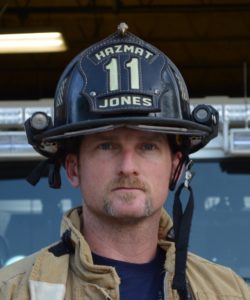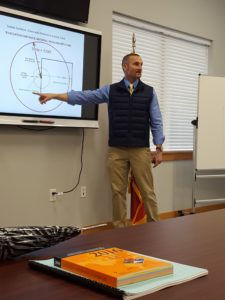
Hazmat Training Expert Casey Jones
Ensuring hazmat students are engaged and learning requires breaking down material into digestible bites, fresh, realistic hands-on scenarios and verifying student understanding.
Casey Jones is a 20-year emergency services veteran including 13 years with the Little Rock (Ark.) Fire Department. He is a lead hazmat instructor not just in the city, but the county and state too. He also trains hazmat instructors on a national level. Casey sat down with us to share his insights on how to make hazmat training effective, relevant, and engaging.
HazSim: What major hazmat threats lie within Little Rock?
Jones: Working in the largest city in Arkansas, the industrial environment gives us a large array of potential hazards. We have several cold-storage facilities which house large volumes of ammonia near residential areas, a natural gas pipeline that runs through downtown, millions of gallons/pounds in transported goods via rail, river and highway, as well as numerous political offices and entertainment events that are sensitive to hazmat and/or weapons of mass destruction threats.
HazSim: Describe Little Rock’s hazmat team.
Jones: LRFD has a dedicated hazmat unit with 4 personnel along with 2 other units at our station that are trained to the technician level as well. Our heavy rescue unit personnel are also trained to the technician level. Hence, we can immediately deploy up to 24 technician-trained personnel to any incident within the city. We average approximately 2.7 responses per shift, which may not seem like much, but these add up when considering incidents such as train derailments or WMDs take considerable time and resources to mitigate. We also have a county hazmat team, which is staffed with full- and part-time personnel from throughout the county.
HazSim: How many students do you have? What is your training facility like?
Jones: At LRFD, I instruct over 400 personnel to the operations level and over 75 to the technician level. We host regular training for our personnel in the form of scenarios and drills. We are lucky to have a large training facility with natural gas, highway tanker, railcar, WMD and confined space props to include in our scenarios.
When training technician level responders, I focus more on mission-specific drills and scenarios. For example, they will not only recognize an incident involving hazardous materials, but they will also identify the material and take measures to contain and mitigate the release.
Besides my fire department career, I am also an instructor for the Arkansas Department of Emergency Management and the Arkansas Fire Academy. I deliver classes at conferences across the US such as HotZone and IAFC’s Hazmat Conference.
Little Rock’s Hazmat Team:
- Dedicated hazmat unit with 4
full time personnel - Average 2.7 responses per
shift - 2 additional station units
trained to technician level - Can immediately deploy up
to 24 technician-trained
personnel - County hazmat team with
full and part time personnel
from throughout the city

HazSim: How do you keep training scenarios from becoming predictable or stale?
Jones: To keep responders interested and engaged in training, it has to be relevant and fun. You can’t have them do the same pretend scenario over and over and expect them to be proficient or confident at their job. While following NFPA 472 and OSHA 1910.120, we have put together a scenario playbook that uses many of the potential incidents we could respond to, both locally and as mutual aid throughout the state. We compound this effect with tours or training at the actual sites when possible.
HazSim: What’s the key to best preparing responders to handle real scenarios outside of the controlled training environment?
Jones: To me, it comes down to how you train and what you train with. You can’t just sit around and talk about “what ifs”, you have to get out and place boots on the ground and equipment in their hands. Having a knowledge base is great, but personnel need to see and feel how environments are affected by products. This is where having realistic training equipment, like the HazSim system, can really improve the capabilities and effectiveness of a hazmat team.
HazSim: What is your biggest obstacle when conducting hazmat training?
Jones: Having all personnel on the same page. A large-scale hazmat incident is rarely a single agency response, and having everyone trained to the same level is hard. Many agencies do not have the same equipment or capabilities, hence, it is hard for all personnel to train with the same equipment and level of understanding.
HazSim: How do you get around it?
Jones: For us, we were lucky enough to purchase several sets of HazSim training equipment for our department and the county hazmat team. These units give us the ability to train our own personnel and surrounding agencies with the same equipment. Thus, everyone learns on the same platform and understands what is going on during a real incident.
HazSim: What wicked hazmat training problem keeps you up at night?
Jones: Is everyone adequately trained? This may seem silly, but I used to love being called by other people and asked what they need to do at incidents. Abraham Maslow describes esteem as one of the most basic of human needs. But, while I’m glad they called, I now ask myself what I forgot to pass on to them. Would they need to call if I trained them well enough?
HazSim: What would it take to solve it?
Jones: Time and effort. I think any instructor feels some sense of responsibility for every student they teach. However, we cannot pass on years of training and experience in a single class. Regular, varied and realistic training is the only way to prepare responders to do their job safely and effectively. As I tell my all my students, plan, prepare, perform.



